The CHGS collections include not only a diverse array of papers and physical objects but also many of the Center’s past lectures and events, as well as a backlog of oral testimonies from survivors of genocide. Not to mention: CHGS partners with the UMN Libraries to promote the USC Shoah Foundation’s Visual History Archive, which includes 55,000+ oral testimonies from genocide survivors.
Although this rich set of materials is used by faculty, students, researchers, and K12 teachers alike, there are obstacles to managing the collections. Arguably central, and accessioned at various points over time, are under-utilized parts of the collections that include artworks, photographs, materials from Center-sponsored exhibitions, and rare items from private donors. Two such collections are the focus of this blog post.
One of the Center’s most prolific photojournalist collections is that of the images captured by Maxine Rude for the UNRRA (United Nations Relief and Rehabilitation Administration). Although the images are available on Elevator, and some are also available via the UMN LIbraries through their digital conservancy platforms, the images are in the process of being rescanned. Furthermore, a lack of item-level descriptions and cataloguing reflects the challenging curatorial decisions at play. Does one strive for clearer distinctions between disparate collections and media (thereby preserving as much as possible about the items’ materiality and provenance), or should one try to thematically link various materials at the risk of overdetermining their relation to one another? And most importantly: if similar materials are found elsewhere through larger archival and library databases, how to best link these materials together and make them accessible to larger audiences?
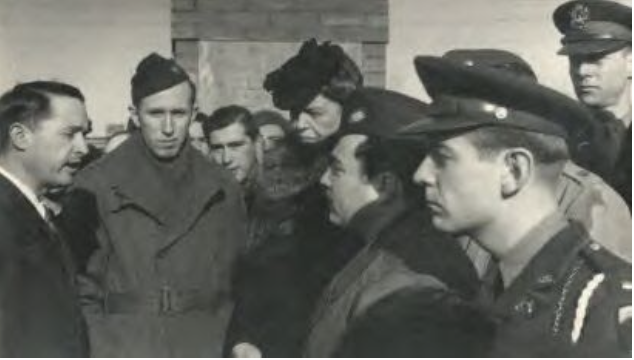
These dilemmas emerge in Rude’s photographs. Although most of Rude’s subjects appear only once, there are a few exceptions. First Lady Eleanor Roosevelt, who visited the Zeilsheim DP (“Displaced Person”) Camp in the American Zone of occupied Germany, appears in three separate photographs, and each photo reflects different geopolitical phenomena present in the camp.
In one photo, Roosevelt and GIs can be seen listening to a male figure, perhaps a DP, although we are unsure based on the limited captioning of the photograph. Professor Alejandro Baer, CHGS Director, has also written about the challenges prior curators faced with this collection, namely: what subject(s) appear? What should viewers glean from an image, and when photographs themselves are incomplete snapshots of a larger scene? One can glean a lot from Roosevelt’s body language as she earnestly listens to her subject, as well as members of the Allied forces looking on, especially as they played outsized roles in the postwar German landscape for decades.
In another photograph (that is currently only available through the Center’s Elevator site) Roosevelt walks past what is presumably the Polish repatriation center that operated in DP camps. A notable early tension between Soviet and American forces was the question of DP repatriation to the Eastern Bloc; should repatriation be forced or voluntary? In this mediated, stylized snapshot, larger political moments are taking center stage, and become part of a larger discussion of world history.
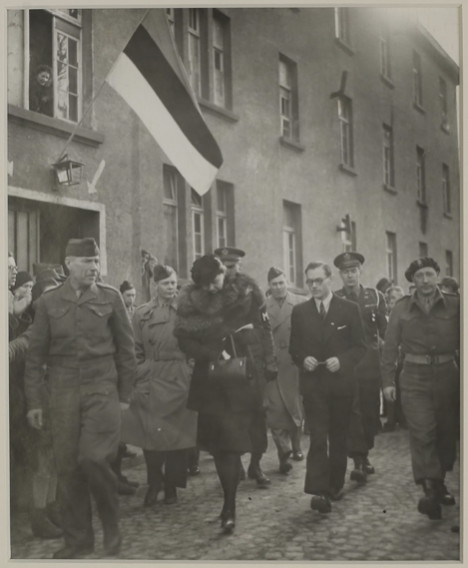
There is one other photo of Roosevelt that caught my eye as a Yiddish speaker. Barely recognizable in the left background, Roosevelt is part of a larger, chaotic scene. Almost in the center of the image is a post with the name of the port city of Jaffa (Hebrew: יפו) and in the background: a banner in Yiddish and English.
Why in English? Certainly, the American lingua franca was ever-present in the DP Camp within the American Zone and among GIs who did not usually have language skills beyond that of English. But more notably, the propagandized English appears alongside Yiddish, which was the lingua franca of 10-12 million Eastern European Jews worldwide prior to the Holocaust and spoken by roughly 4.5 million of the 6 million Jews murdered. The Yiddish (מיר װילן גײן! מיר מוזן גײן! און מיר װעלן גײן קײן אַרץ־ישׂראל / Mir viln geyn! Mir muzn geyn! Un mir veln geyn keyn Erets-Yisroel!) matches the English: We want to go! We have to go! We will go to Palestine!
Much of this information is irrelevant to the average viewer of this photograph, and especially within the larger context of the dozens of photographs taken by Maxine Rude in the collections. And too much curation leads to overdetermined description and information. I can’t help but ask: what do I glean from this photograph? There is certainly too much to say within the span of one blog post, and more importantly: others will have different readings of this image. But my first reaction upon seeing the Yiddish: can I take the banner at its word? Does this image represent DPs’ mass exodus to Palestine following World War II?
It is certainly true that life in DP Camps was not easy, and it took years for foreign governments to allow DPs to be resettled in other parts of the world. For many Jewish survivors from Eastern Europe, many simply waited to go to the British Mandate of Palestine (either with or without the British government’s permission), even if for political reasons, not all wanted to go, according to survivors and children of DPs recounting their postwar journeys out of Europe.
In fact, many personal accounts point to the complicated feelings DP’s had for the destinations in question. Many certainly believed anything was better than languishing in camps on German soil. But as was the case with resettlement in Palestine, many were uncertain of their prospects in the US, having been active in Yiddishist or leftist politics in the interwar years.
What we do know, however: DP resettlement was often arbitrary, and it echoes various trends that continue to play out today in harsh refugee policies playing out globally.
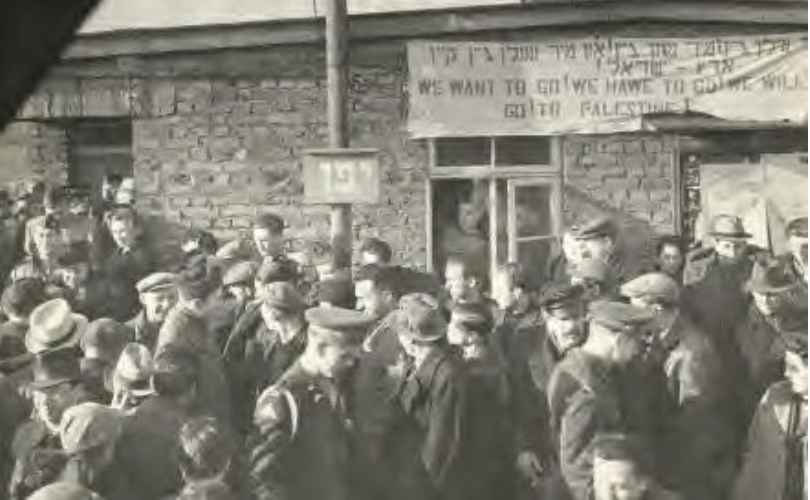
These photos, taken by Rude, are just a few examples of the rare historical images in the Center’s archive. In addition, the digitizations, descriptions (or lack thereof) etc. I have included in this blog entry represent insights as well as challenges for community archives when permanently preserving and curating these collections for in-person and online use.
Usable item descriptions (or even a lack thereof) can, however, lead to additional problems with categorization. As a Yiddish speaker interested in any other Yiddish artifacts I could find, I was thus surprised to find a photo album, out of place among various materials related to the Third Reich. The photo album did not appear to have been donated with the Nazi-related items in question.
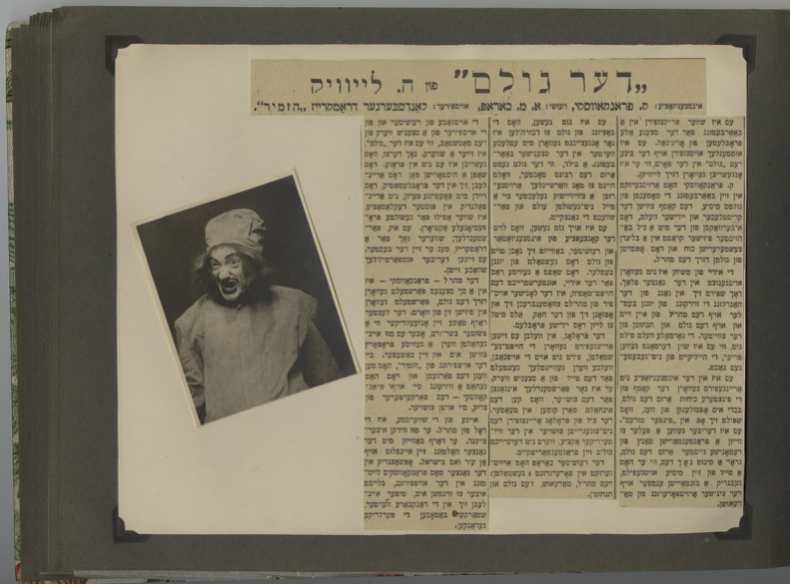
The album was a personal item from Kenneth and Jeanette Frank, two donors who lived in Saint Paul, Minnesota. They had been active in Yiddish theater in the Landsberg am Lech DP Camp after having survived the Holocaust. The two did not have any children, and at some point in the 1990s prior to their deaths had donated the object to the Center or its former director, Stephen Feinstein. Kenneth Frank is in several of the pictures, cast as the Maharal of Prague (Rabbi Loew) in H Leyvik’s well-known play, Der Goylem (The Golem). The troupe also produced Yankev Gordin’s “Der vilder mentsh” (The Wild Man).
Other materials with the photo album that are equally important to contextualize and preserve for educators and researchers: handwritten notes (it is unclear by whom, presumably to detail images and documents in Yiddish that are difficult to decipher without someone fluent in the language), and a large pamphlet given to passengers onboard the USS Muir, a navy transport ship used for a time in the fifties to transport DPs to various corners of the globe.
Also included were announcements from the U.S. Displaced Persons Commission in Frankfurt (am Main), translated into Yiddish for passengers on board the ship regarding U.S. Customs regulations.
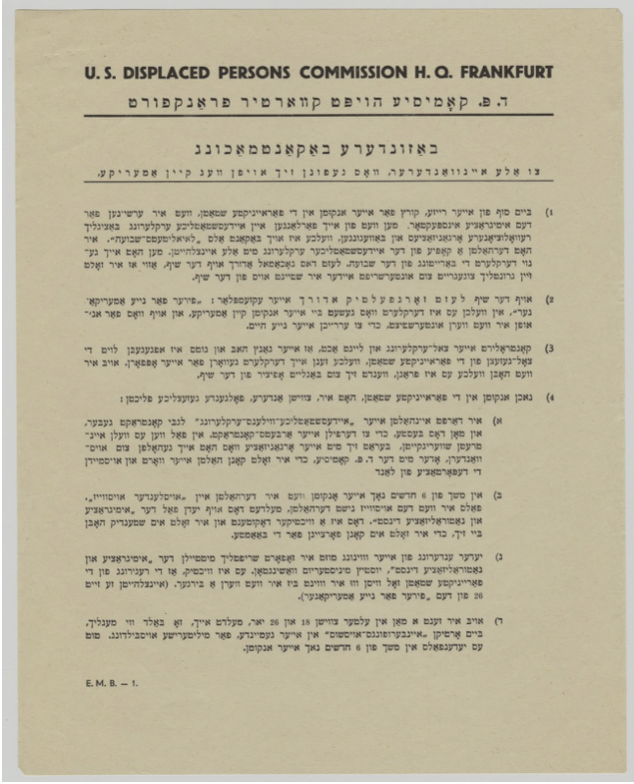
Also available are laminated scans of Yiddish newspaper clippings from the DP Camps published in transliterated Yiddish, reflecting the lack of Yiddish typesets available at the time. Many of the typesets were “unavailable” (i.e., they had been destroyed during the war), and Yiddish journalists had to resort to transliteration for publications. Although some of the materials inserted into the photo album use Yiddish orthography, many use Latin fonts, which reflect this reality.
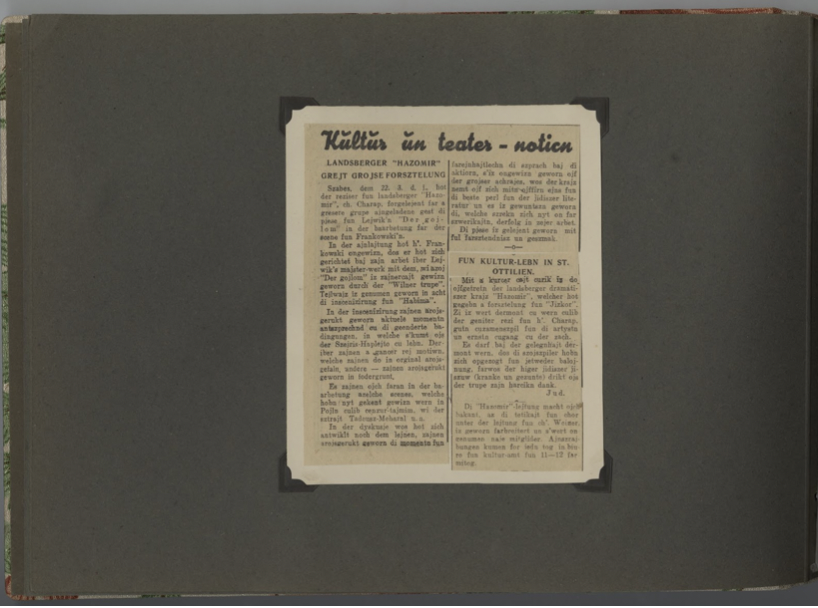
Apart from the find itself (i.e., that this photo album existed in the collections in the first place), I can’t help but note what it depicts: the memory of genocide survivors who, even after losing their homes and much (if not all) of their extended family, a continued act of resistance came in in the form of cultural production (i.e., staging masterpieces of Yiddish theater. The photo album, initially categorized as restricted, is now publicly available on the Center’s collections site.
Meyer Weinshel is the center’s educational outreach and special collections coordinator, and a PhD candidate in Germanic Studies. He is completing a dissertation on translations of German poetry into Yiddish before and after the Second World War. In addition to teaching German Studies coursework at the University of Minnesota, he has also been active in Yiddish language pedagogy and revival. He helped pilot the Yiddish Book Center’s new language textbook in Twin Cities, and worked for the Yiddish Book Center’s intensive summer language program for undergraduate students in 2020. In addition to working for CHGS, he was also a visiting lecturer of Yiddish Studies at the Ohio State University in 2021.

Comments